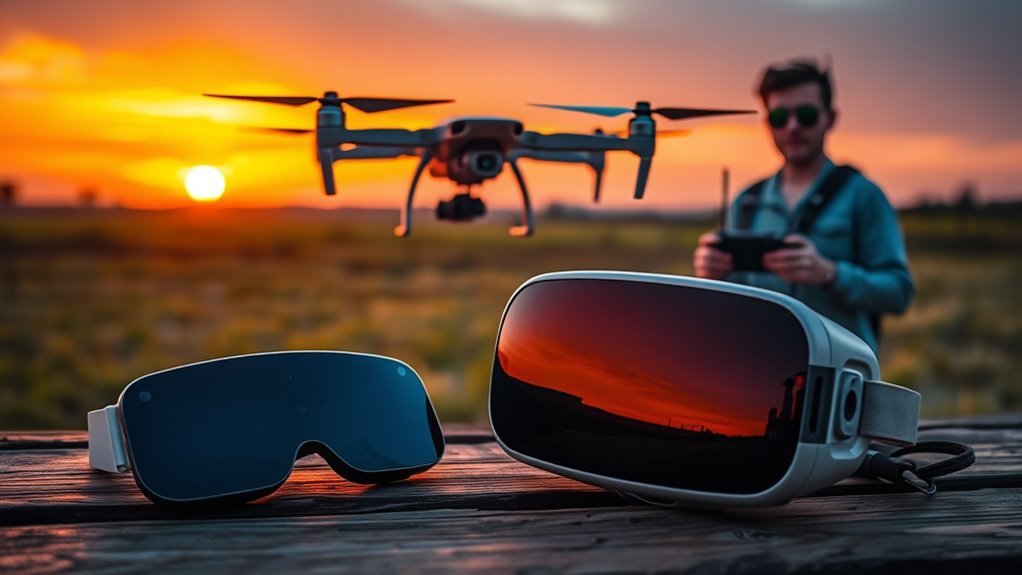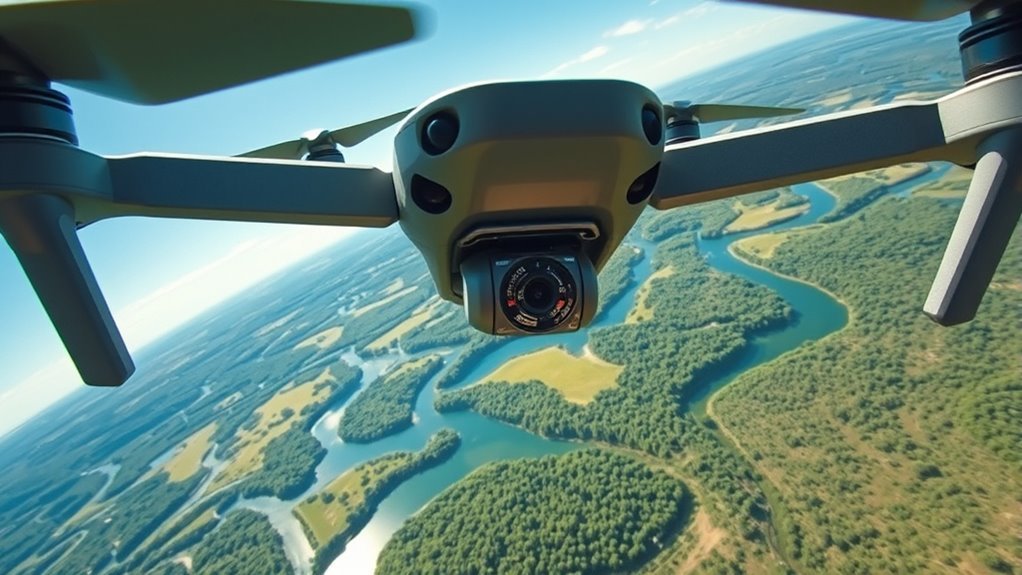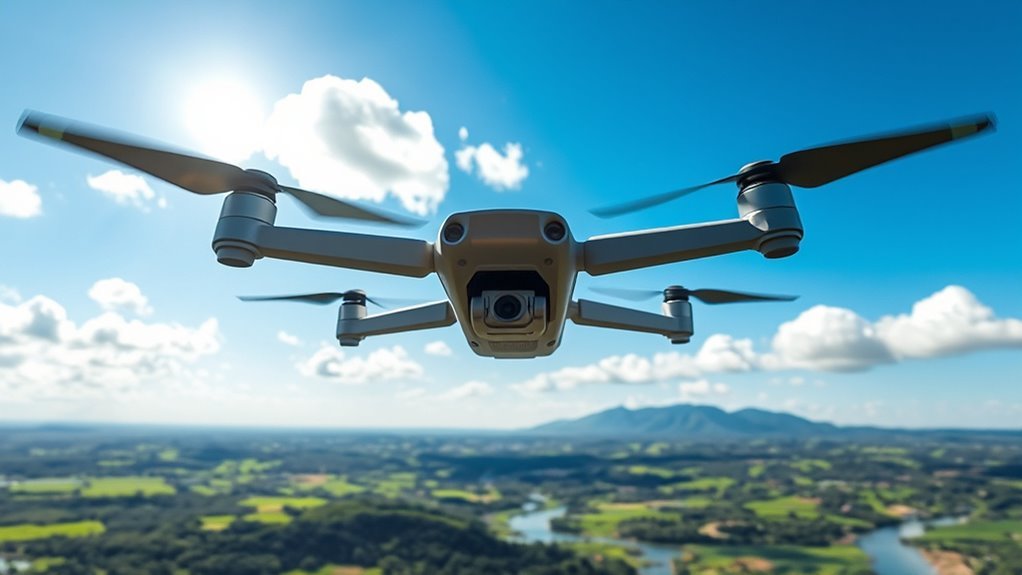FPV flying offers an exhilarating way to experience the skies, making you feel like you’re piloting from the cockpit. Start by choosing the right gear, including a drone that’s suited for your skill level. Setting up involves securing the camera, calibrating the settings, and understanding basic flight techniques. You’ll also need to master advanced maneuvers while adhering to safety protocols and regulations. Continue exploring these essential steps to elevate your FPV flying experience even further.
Understanding FPV Flying: What It Is and Why It’s Exciting

When you immerse yourself in the world of FPV (First-Person View) flying, you’re not just piloting a drone; you’re experiencing a thrilling perspective that makes you feel like you’re in the cockpit. The FPV history dates back to the early 2000s, evolving from simple remote control models to today’s advanced drones equipped with high-definition cameras and real-time video feeds. This immersive experience allows you to navigate through landscapes with the freedom of a bird, soaring above mountains or diving through forests. The adrenaline rush of maneuvering at high speeds and the ability to explore the world from a unique angle are what truly sets FPV apart. It’s more than a hobby; it’s a gateway to adventure and creativity. With options like the 3-axis gimbal for image stabilization, FPV flying takes your aerial photography to new heights.
Essential Gear for FPV Flying

To get started with FPV flying, you’ll need the right gear to guarantee an ideal experience. You’ll want to take into account recommended drone models that suit your skill level, alongside a necessary accessories checklist to enhance your setup. Having the right tools not only boosts performance but also elevates your overall flying experience. For example, choosing a model like the DJI Avata Pro-View can significantly improve your initial learning curve due to its stable handling and responsive controls. Additionally, selecting a drone with advanced stabilization systems can enhance your flight experience by providing smoother footage and greater control during challenging maneuvers.
Recommended Drone Models
As you immerse yourself in the exciting world of FPV flying, choosing the right drone model is essential for enhancing your experience and ensuring peak performance. For beginners, the Eachine Wizard X220 and the Holy Stone HS720 are excellent recommendations. They offer stability, good flight times, and user-friendly interfaces, making them perfect for newcomers.
When making drone comparisons, consider factors like camera quality, range, and battery life. The DJI Mini 2 also stands out for its compact design and impressive features, allowing you to capture breathtaking aerial footage without overwhelming complexity. As you explore various models, prioritize your needs and budget, ensuring you select a drone that aligns with your desire for freedom and adventure in the skies.
Necessary Accessories Checklist
Essential gear can make or break your FPV flying experience, so having the right accessories is crucial. Start with battery types; LiPo batteries are popular due to their power-to-weight ratio. Make sure to have a few spares to keep you flying longer. Next, consider your antenna selection. A good antenna can improve your signal range and reduce interference, enhancing your overall experience. Don’t forget about a quality FPV headset or goggles for an immersive view. A ground station can also help you monitor your drone’s telemetry. Finally, invest in protective gear for your drone, like prop guards, to keep it safe during those adventurous flights. With the right accessories, you’ll be ready to explore the skies freely!
Choosing Your First FPV Drone

When you’re ready to choose your first FPV drone, it’s crucial to understand the different types available and their key features. Consider what you’ll primarily use it for, whether it’s racing, freestyle, or casual flying, as this will impact your decision. Additionally, setting a budget upfront will help narrow down your options and guarantee you get the best value for your investment.
Types of FPV Drones
Choosing your first FPV drone can be an exciting yet overwhelming experience, especially with the myriad of options available. You’ll want to evaluate what type suits your flying style. Racing drones are built for speed and agility, perfect for thrilling competitions. If you’re keen on capturing stunning visuals, cinematic drones are your best bet. Long range drones offer extended flight times, ideal for exploring vast landscapes. Whoop drones are mini-sized and great for indoor flying, making them beginner-friendly. For those craving tricks and maneuvers, freestyle drones provide the freedom to experiment. Finally, drone kits can be a fun way to learn, allowing you to build and customize your own FPV experience. Choose wisely, and let your adventure begin!
Key Features to Consider
Maneuvering the world of FPV drones involves understanding several key features that can greatly impact your flying experience. When choosing your first drone, keep an eye on camera quality, as it affects your visual experience. Flight time is essential; longer durations mean more freedom in the skies. Durability features guarantee your drone withstands crashes, while weight capacity affects what you can carry. Control range is critical for exploring vast areas, and battery type influences flight efficiency. Stabilization technology enhances your footage, and a user-friendly interface can greatly ease your learning curve.
| Feature | Importance | Considerations |
|---|---|---|
| Camera Quality | Affects visual experience | HD vs. 4K |
| Flight Time | Determines how long you fly | 10-30 minutes |
| Durability Features | Guarantees longevity | Materials and design |
Budgeting for Your Drone
While maneuvering the world of FPV drones can be exciting, budgeting for your first one is essential to ensuring a satisfying experience without breaking the bank. A thorough cost analysis will help you make informed decisions. Here’s a simple way to allocate your budget:
- Drone Frame: Choose a solid, lightweight frame.
- Camera: Invest in a quality FPV camera for clear visuals.
- Transmitter & Receiver: Essential for controlling your drone effectively.
- Batteries: Don’t skimp here; extra batteries extend your flight time.
- Accessories: Include tools, chargers, and spare parts in your budget allocation.
Setting Up Your FPV Equipment
Setting up your FPV (First Person View) equipment can seem challenging, but with the right approach, it becomes a straightforward process. First, mount your camera securely on the drone, making sure it’s aimed correctly for the best perspective. Next, connect the camera to your video transmission system; this allows real-time footage to reach your goggles or screen. Don’t forget to perform camera calibration to guarantee the colors and exposure settings are accurate, enhancing your viewing experience. Once everything’s connected, power on your equipment and check the video feed for clarity and stability. Adjust the antenna for maximum signal strength to minimize interference. With these steps completed, you’re ready to experience the exhilarating freedom of FPV flying!
Learning the Basics of FPV Flight
Once you’ve got your FPV equipment set up, it’s time to familiarize yourself with the basics of flight. Your first flight experiences can be exhilarating, but mastering basic flight techniques is essential for a smooth ride. Here are key aspects to focus on:
- Throttle Control: Learn to gently adjust your speed.
- Yaw, Pitch, and Roll: Understand how to maneuver your drone effectively. Maintaining flight stability is crucial for overcoming turbulence.
- Altitude Management: Practice maintaining a steady height.
- Orientation Awareness: Always know the direction your drone is facing.
- Emergency Landings: Be prepared to land safely in case of issues. Understanding your drone’s maximum flight duration can also help you plan your flights more effectively.
Mastering Advanced Flight Maneuvers
As you gain confidence in basic flight techniques, you’ll want to take your skills to the next level by mastering advanced maneuvers. Advanced acrobatics can truly release your drone’s potential, allowing you to perform flips, rolls, and dives that will wow your audience. To excel in these maneuvers, it’s essential to develop precision control; the slightest adjustment can make a massive difference in your drone’s performance. Start slowly by practicing in an open space, gradually increasing complexity as you feel comfortable. Use your FPV goggles to gauge depth perception, enhancing your spatial awareness. With dedication and practice, you’ll find that these advanced techniques not only elevate your flying but also give you a newfound sense of freedom in the skies. Additionally, understanding intelligent flight modes can enhance your ability to execute complex maneuvers with greater ease and confidence. Consider incorporating features like battery capacity management in your practice sessions to further enhance the endurance of your flights.
Safety Tips and Regulations for FPV Pilots
Mastering advanced flight maneuvers not only enhances your skills but also brings with it the responsibility of flying safely. To enjoy the freedom of FPV flying, you need to prioritize safety protocols and guarantee regulatory compliance. Here are some essential tips:
- Always maintain visual line of sight with your drone.
- Fly in designated areas and avoid crowded places.
- Check local regulations regarding drone flight.
- Keep your drone within the specified weight limits.
- Use proper fail-safe measures to prevent accidents.
- Be aware of signal strength and environmental factors that can affect your drone’s range, including battery capacity which directly influences flight duration and distance.
Frequently Asked Questions
What Are Common Mistakes Beginners Make in FPV Flying?
Think of flying as sailing; without proper battery management and understanding flight modes, you might capsize your journey. Beginners often overlook these, leading to short flights and missed opportunities. Stay aware, and you’ll soar!
How Can I Improve My FPV Flying Skills Quickly?
To improve your FPV flying skills quickly, focus on practice techniques like simulator training and real-world flights. Consider equipment upgrades too, as better gear can enhance your experience and boost your confidence in the air.
What Maintenance Do FPV Drones Require?
FPV drones need regular maintenance to guarantee peak performance. You should focus on battery care, propeller inspection, frame maintenance, and software updates. Staying on top of these tasks keeps your flying experience smooth and exhilarating.
Can I Use My FPV Drone for Photography?
Yes, you can use your FPV drone for photography! Just adjust your drone settings for ideal image quality, and embrace the freedom of capturing stunning aerial shots. It’s all about practice and creativity!
What Are the Best Online Resources for FPV Learning?
You’d think mastering FPV would be easy without resources, right? Check out online courses and video tutorials; they’ll elevate your skills. Embrace the freedom to soar with confidence and creativity through expert guidance and community support!

